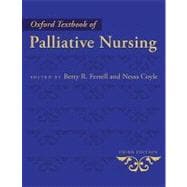
| Forewords | |
| Preface | |
| General Principles | |
| Introduction to Palliative Care Nursing Care | |
| Hospice Care in the 21st Century: A Model for Quality End-of-Life Care | |
| Hospital-Based Palliative Care | |
| Principles of Patient and Family Assessment | |
| Communication in Palliative Care: An Essential Competency for Nurses | |
| Symptom Assessment and Management | |
| Pain Assessment | |
| Pain at the End of Life | |
| Fatigue | |
| Anorexia and Cachexia | |
| Nausea and Vomiting | |
| Dysphagia, Xerostomia, and Hiccups | |
| Bowel Management: Constipation, Diarrhea, Obstruction, and Ascites | |
| Hydration, Thirst, and Nutrition | |
| Dyspnea, Death Rattle, and Cough | |
| Urinary Tract Disorders | |
| Lymphedema Management | |
| Skin Disorders: Pressure Ulcers-Assessment and Management | |
| Skin Disorders: Malignant Wounds, Fistulas, and Stomas | |
| Pruritus, Fever, and Sweats | |
| Neurological Disturbances | |
| Anxiety and Depression | |
| Delirium, Confusion, and Agitation | |
| Insomnia | |
| Sexuality | |
| Clinical Interventions, Economic Outcomes, and Palliative Care | |
| Urgent Syndromes at the End of Life | |
| Sedation for Refractory Symptoms and Terminal Weaning | |
| Complementary and Alternative Therapies in Palliative Care | |
| Withdrawal of Life Sustaining Treatment | |
| The Meaning of Hope in the Dying | |
| The Meaning of Hope in the Dying | |
| Bereavement | |
| Supporting Families in Palliative Care | |
| Planning for the Actual Death | |
| Spiritual Care | |
| Spiritual Assessment | |
| Spiritual Care Interventions | |
| Meaning in Illness | |
| Special Patient Populations | |
| Caring for those with Chronic Illness | |
| Cultural Considerations in Palliative Care | |
| Elderly Patients | |
| Poor, Homeless, and Underserved Populations | |
| Palliative Care in Psychiatric Illness | |
| Patients with Acquired Immunodeficiency Syndrome: Caring from Diagnosis to Long Term Survival or Death | |
| Caring for the Drug-Addicted Patient at the End of Life | |
| Cancer Survivorship | |
| End-of-Life Care Across Settings | |
| Improving the Quality of Care Across All Settings | |
| Long-Term Care | |
| Home Care | |
| The Intensive Care Unit | |
| The Outpatient Setting | |
| Rehabilitation and Palliative Care | |
| The Emergency Department | |
| The Role of Nursing in Caring for Patients Undergoing Surgery for Advanced Disease | |
| Palliative Chemotherapy and Clinical Trials in Advanced Cancer: The Nurse's Role | |
| Pediatric Palliative Care | |
| Symptom Management in Pediatric Palliative Care | |
| Pediatric Care: The Hospice Perspective | |
| Pediatric Care: Transitioning Goals of Care in the Emergency Department, Intensive Care Unit, and in Between | |
| End-of-life Decision Making in Pediatric Oncology | |
| Palliative Care in the Neonatal Intensive Care Unit | |
| Grief and Bereavement in Pediatric Palliative Care | |
| Pediatric Pain: Knowing the Child Before You | |
| Special Issues for the Nurse in End-of-Life Care | |
| The Advanced Practice Nurse | |
| The Experience of the Nurse in End-of-Life Care in the 21st Century: Mentoring the Next Generation | |
| Ethical Considerations | |
| Public Policy and End-of-Life Care: The Nurse's Role | |
| Palliative Care and Requests for Assistance in Dying | |
| Nursing Education | |
| Nursing Research | |
| Teamwork in Palliative Care | |
| International Models of Palliative Care | |
| International Models of Palliative Care Reflecting Various Stages of National Development | |
| Canada | |
| Palliative Care in Australia and New Zealand | |
| Palliative Care in the United Kingdom Public Policy and End-of-Life Care: The Nurse's Role | |
| Palliative Care in Europe | |
| Palliative Care in Situations of Conflict | |
| Palliative Care in South America | |
| Palliative Care in Africa | |
| Palliative Care in Japan | |
| Conclusion: A Good Death | |
| Understanding a Good Death | |
| Appendix: Palliative Care Resource List | |
| Table of Contents provided by Publisher. All Rights Reserved. |
The New copy of this book will include any supplemental materials advertised. Please check the title of the book to determine if it should include any access cards, study guides, lab manuals, CDs, etc.
The Used, Rental and eBook copies of this book are not guaranteed to include any supplemental materials. Typically, only the book itself is included. This is true even if the title states it includes any access cards, study guides, lab manuals, CDs, etc.